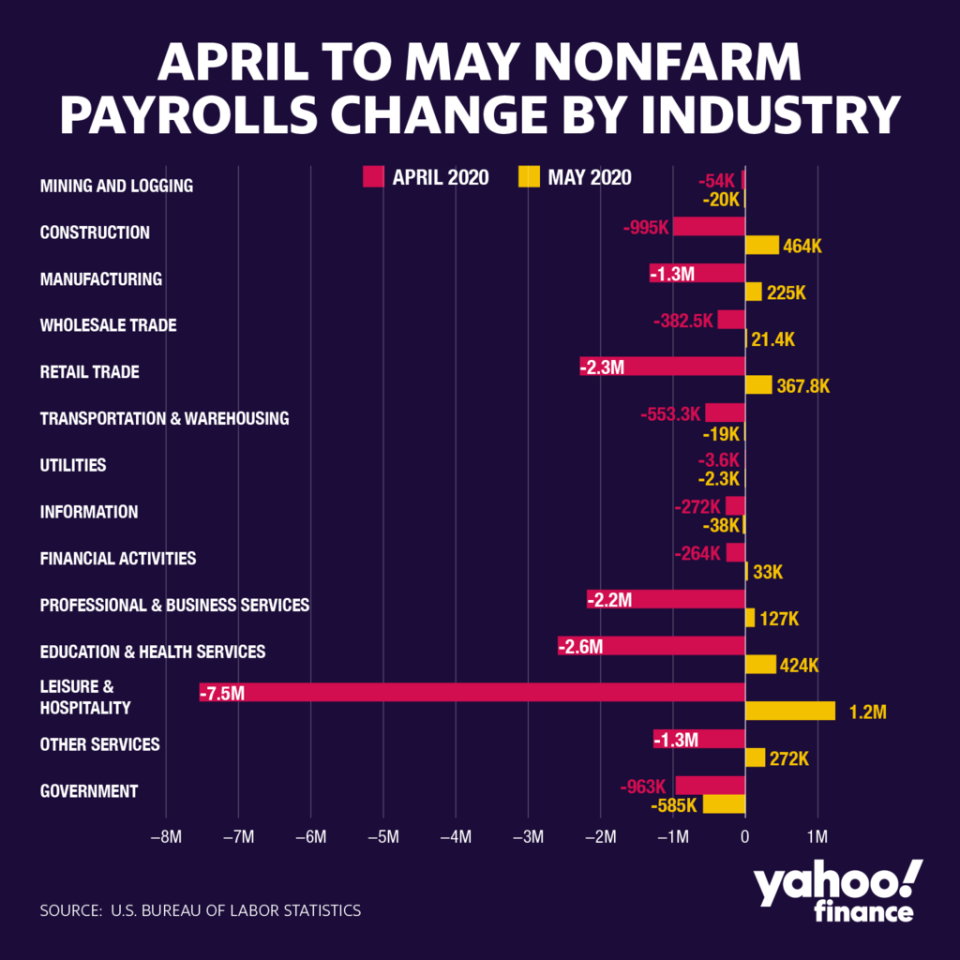May's jobs report surprise masked weaknesses that could make the rebound a 'head fake'
To paraphrase Mark Twain, reports about the labor market’s recovery may be greatly exaggerated.
The U.S. is undoubtedly in the throes of a deep recession fomented by the coronavirus pandemic. Yet Friday’s nonfarm payrolls report showed employers added a stunning 2.5 million jobs in May — a shock to the system for a market convinced the world’s largest economy was in freefall.
There were certainly reasons to be cheerful about the data, among them a sharp rebound in leisure and hospitality, hammered by COVID-19 restrictions that only recently began to loosen. The unemployment rate also posted a surprise drop to 13.3% from a post-war high, while the labor force participation rate jumped.
The numbers underscored how massive monetary and fiscal stimulus have undergirded the economy, while cementing expectations of a faster-than-anticipated recovery.
And therein lies the risk, according to Mohamed El Erian, chief economic adviser at Allianz, who warned of a potential “major head fake” that could lessen the appetite in Washington for more economic support.
In theory, the May report might be “picking up the impact of data distortions and policy distortions” that could make Congress do less, he told Yahoo Finance on Friday. “That’s the nightmare scenario.”
Several economists noted that black unemployment rose as joblessness among whites fell. Additionally, May’s “startling” hiring boom masked a hemorrhaging in a government sector that shed over half a million jobs, Ian Shepherdson, Pantheon Macroeconomics’ chief economist, said on Friday.
Given that at least 40 million people have lost their jobs since March, “the level of payroll employment is now at its late 2011 level. The way back is long,” Shepherdson said.
Meanwhile, workers’ average hourly earnings tumbled by 1.0% at a rate well below consensus, underscoring how employment gains aren’t translating into fatter paychecks — a persistent concern even before the COVID-19 crisis hit.
And Deutsche Bank noted that the unemployment rate for those without a high school diploma checked in at 20% — far above May’s national average at 13.3%. Among other deficiencies, the bank also found millennial unemployment at recession levels, and that a whopping 102 million people still aren’t in the workforce.
Economists believe that as more states ease their lockdowns, the beleaguered jobs market will be bolstered. Still, “we still think it will be a long time before the labour market is anywhere near back to its pre-virus state,” said Michael Pearce, senior U.S. economist at Capital Economics.

‘Unlikely to need as many staff as they had before’
What’s more, the restrictions against large gatherings and face masks that have become ubiquitous are more than likely to remain a fixture of post-lockdown life — even in office buildings. In former hotspots like New York and New Jersey that have begun reopening, strict capacity limits will crimp business revenues in places that rely on heavy foot traffic.
“While we do expect a continued surge in hiring in the coming months, the need for continued physical distancing well into the future suggests there will still be lingering damage in some industries, with the unemployment rate remaining elevated for years,” Pantheon’s Shepherdson wrote.
Despite the encouraging rebound, ING chief international economist James Knightly warned that “caution is still warranted.” He pointed to the near-apocalypse in retail and restaurants, which are suffering from mass closures and bankruptcies.
“Most restaurants and retailers are unlikely to need as many staff as they had before the pandemic hit given social distancing limiting customer numbers at any given time,” Knightly wrote in a research note.
“Many businesses may simply take the view that it isn’t economically viable for them to open at this stage and remain closed, particularly in big cities where office blocks will remain shut for some time to come and there isn’t a flow of customers,” he added.
“We also have to remember that even after today's great numbers, US employment is still 19.55 million lower than it was in February,” Knightly wrote.”We still have a long way to go.”
Javier David is an editor for Yahoo Finance. Follow him on Twitter: @TeflonGeek
Follow Yahoo Finance on Twitter, Facebook, Instagram, Flipboard, LinkedIn, and reddit.
Find live stock market quotes and the latest business and finance news
